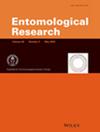Assessing the Influence of Corn and Artificial Diet on the Growth Performance and Nutritional Efficiency of Conogethes punctiferalis
Abstract
This study investigates the effects of corn and an artificial diet on life history, and nutritional physiology of Conogethes punctiferalis larvae. Nutritional indices such as food consumption index (CI) and relative growth rate (RGR) were evaluated for the fourth and fifth instars on both diets. The results indicated no significant difference in CI between the diets. However, RGR was significantly higher for larvae reared on corn (p < 0.05). Fifth-instar larvae on corn exhibited the highest RGR (1.08 ± 0.01), while the lowest RGR was observed for 1-day-old fourth instars on artificial diet (0.02 ± 3.21). The efficiency of conversion of ingested food (ECI) and digested food (ECD) were also significantly higher for larvae on corn (p < 0.05), suggesting superior nutrient assimilation and conversion efficiency compared to artificial diet. Despite similar developmental durations, larvae on artificial diet had a higher survival rate (87.32%) than those on corn (75.01%). Pupal weight was slightly higher on artificial diet, but fecundity was greater on artificial diet (133.63 eggs with 90.76% fertility) compared to corn (129.67 eggs with 86.60% fertility). These findings indicate that corn while promoting higher growth rates and nutrient utilization efficiency, may include less digestible components, whereas artificial diet offers better overall survival and reproductive outcomes. This highlights the potential of optimizing artificial diets to enhance the laboratory rearing efficiency of C. punctiferalis for research and pest management applications.

 求助内容:
求助内容: 应助结果提醒方式:
应助结果提醒方式:


